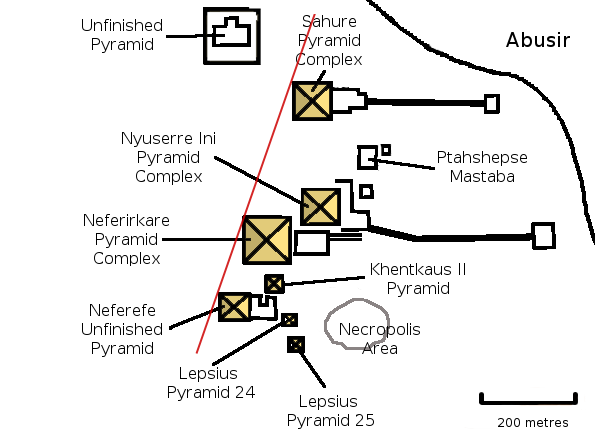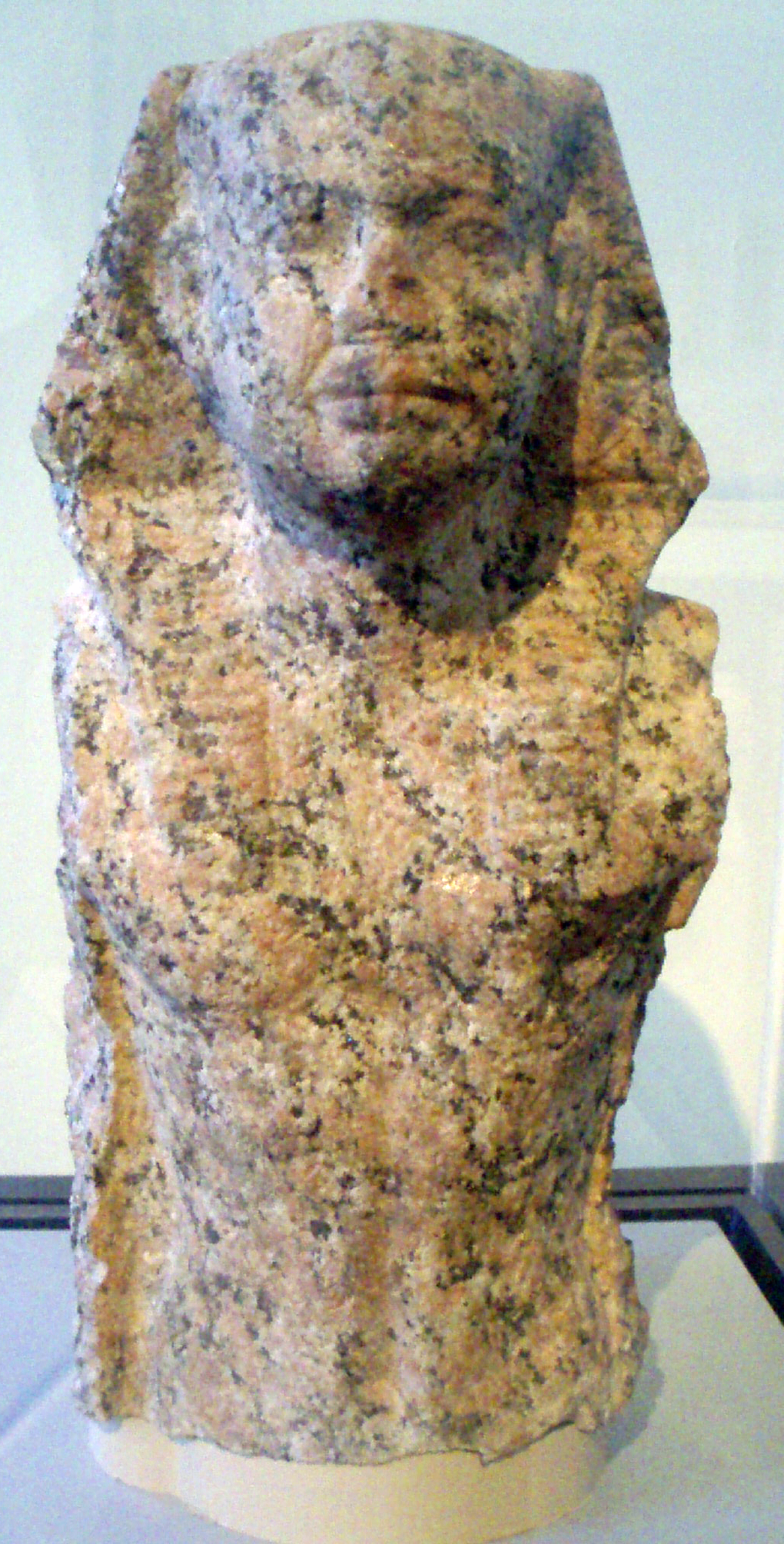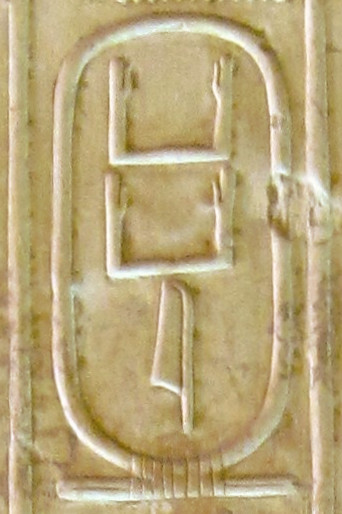|
Unfinished Pyramid Of Abusir
The unfinished pyramid of Abusir is an abandoned pyramid complex located in the necropolis of Abusir whose construction began in the Fifth Dynasty. It is speculatively assigned to Shepseskare, an ephemeral pharaoh whose brief rule is the least well documented of the Fifth Dynasty. Exploration The structure was discovered at the beginning of the 1980s by a Czech archaeological team led by Miroslav Verner, who noticed the levelled ground and the T shaped burial trench. Relatively little is known about the structure. It is situated between the pyramid of Sahure and the sun temple of Userkaf, and thus probably post-dates their construction. It is evidently aligned astronomically. The project was abandoned after only a few weeks, as evidenced by the presence of incomplete preparatory work. Attribution and chronology Deciphering the genealogy and chronology of the Fifth Dynasty has been a complex problem for historians due to the dearth and ambiguity of available historical sourc ... [...More Info...] [...Related Items...] OR: [Wikipedia] [Google] [Baidu] |
Shepseskare
Shepseskare or Shepseskara (Ancient Egyptian language, Egyptian for "Noble is the Soul of Ra") was an Ancient Egyptian pharaoh, the fourth or fifth ruler of the Fifth Dynasty of Egypt, Fifth Dynasty (2494–2345 BC) during the Old Kingdom of Egypt, Old Kingdom period. Shepseskare lived in the mid-25th century BC and was probably the owner of an unfinished pyramid in Abusir, which was abandoned after a few weeks of work in the earliest stages of its construction. Following historical sources, Shepseskare was traditionally believed to have reigned for seven years, succeeding Neferirkare Kakai and preceding Neferefre on the throne, making him the fourth ruler of the dynasty. He is the most obscure ruler of this dynasty and the Egyptologist Miroslav Verner has strongly argued that Shepseskare's reign lasted only a few months at the most, after that of Neferefre. This conclusion is based upon the state and location of Shepseskare's unfinished pyramid in Abusir as well as the very sma ... [...More Info...] [...Related Items...] OR: [Wikipedia] [Google] [Baidu] |
Nyuserre
Nyuserre Ini (also Niuserre Ini or Neuserre Ini; in Greek language, Greek known as Rathurês, ''Ῥαθούρης'') was an Ancient Egyptian pharaoh, the sixth ruler of the Fifth dynasty of Egypt, Fifth Dynasty during the Old Kingdom period. He is credited with a reign of 24 to 35 years depending on the scholar, and likely lived in the second half of the 25th century BCE. Nyuserre was the younger son of Neferirkare Kakai and queen Khentkaus II, and the brother of the short-lived king Neferefre. He may have succeeded his brother directly, as indicated by much later historical sources. Alternatively, Shepseskare may have reigned between the two as advocated by Miroslav Verner, albeit only for a few weeks or months at the most. The relation of Shepseskare with Neferefre and Nyuserre remains highly uncertain. Nyuserre was in turn succeeded by Menkauhor Kaiu, who could have been his nephew and a son of Neferefre. Nyuserre was the most prolific builder of his dynasty, having built thre ... [...More Info...] [...Related Items...] OR: [Wikipedia] [Google] [Baidu] |
List Of Egyptian Pyramids
This list presents the vital statistics of the pyramids listed in chronological order, when available. See also * Egyptian pyramids * Great Sphinx of Giza * Lepsius list of pyramids * List of Egyptian pyramidia * List of the oldest buildings in the world * Umm El Qa'ab Umm El Qaʻāb (sometimes romanised Umm El Gaʻab, ar, أم القعاب) is a necropolis of the Early Dynastic Period kings at Abydos, Egypt. Its modern name means "Mother of Pots" as the whole area is littered with the broken pot shards of of ... References and notes Bibliography * {{DEFAULTSORT:List Of Egyptian Pyramids Pyramids, Egyptian Ancient Egypt-related lists Pyramids in Egypt ... [...More Info...] [...Related Items...] OR: [Wikipedia] [Google] [Baidu] |
Mortuary Temple
Mortuary temples (or funerary temples) were temples that were erected adjacent to, or in the vicinity of, royal tombs in Ancient Egypt. The temples were designed to commemorate the reign of the Pharaoh under whom they were constructed, as well as for use by the king's cult after death. Some refer to these temples as a cenotaph. These temples were also used to make sacrifices of food and animals. A mortuary temple is categorized as a monument. History Mortuary temples were built around pyramids in the Old Kingdom and Middle Kingdom. However, once the New Kingdom pharaohs began constructing tombs in the Valley of the Kings, they built their mortuary temples separately. These New Kingdom temples were called "mansions of millions of years" by the Egyptians. The mortuary temples were also used as a resting place for the boat of Amun at the time of the Beautiful Festival of the Valley, during which the cult statue of the deity visited the west bank of Thebes. It was a part of the kin ... [...More Info...] [...Related Items...] OR: [Wikipedia] [Google] [Baidu] |
Pyramid Of Neferirkare
The pyramid of Neferirkare (Egyptian: ''Bꜣ Nfr-ỉr-kꜣ-rꜥ'' "the Ba of Neferirkare") was built for the Fifth Dynasty pharaoh Neferirkare Kakai in the 25th century BC. It was the tallest structure on the highest site at the necropolis of Abusir, found between Giza and Saqqara, and still towers over the necropolis. The pyramid is also significant because its excavation led to the discovery of the Abusir Papyri. The Fifth Dynasty marked the end of the great pyramid constructions during the Old Kingdom. Pyramids of the era were smaller and becoming more standardized, though intricate relief decoration also proliferated. Neferirkare's pyramid deviated from convention as it was originally built as a step pyramid: a design that had been antiquated after the Third Dynasty (26th or 27th century BC). This was then encased in a second step pyramid with alterations intended to convert it into a true pyramid; However, the pharaoh's death left the work to be completed by his successors ... [...More Info...] [...Related Items...] OR: [Wikipedia] [Google] [Baidu] |
Niuserre
Nyuserre Ini (also Niuserre Ini or Neuserre Ini; in Greek known as Rathurês, ''Ῥαθούρης'') was an Ancient Egyptian pharaoh, the sixth ruler of the Fifth Dynasty during the Old Kingdom period. He is credited with a reign of 24 to 35 years depending on the scholar, and likely lived in the second half of the 25th century BCE. Nyuserre was the younger son of Neferirkare Kakai and queen Khentkaus II, and the brother of the short-lived king Neferefre. He may have succeeded his brother directly, as indicated by much later historical sources. Alternatively, Shepseskare may have reigned between the two as advocated by Miroslav Verner, albeit only for a few weeks or months at the most. The relation of Shepseskare with Neferefre and Nyuserre remains highly uncertain. Nyuserre was in turn succeeded by Menkauhor Kaiu, who could have been his nephew and a son of Neferefre. Nyuserre was the most prolific builder of his dynasty, having built three pyramids for himself and his queens ... [...More Info...] [...Related Items...] OR: [Wikipedia] [Google] [Baidu] |
Pyramid Of Sahure
The pyramid of Sahure () is a pyramid complex built in the late 26th to 25th century BC for the Egyptian pharaoh Sahure of the Fifth Dynasty. It introduced a period of pyramid building by Sahure's successors in Abusir, on a location earlier used by Userkaf for his sun temple. The site was first thoroughly excavated by Ludwig Borchardt between March 1907 and 1908, who wrote the standard work () between 1910 and 1913. The pyramid complex's layout was adopted by succeeding kings of the Fifth and Sixth Dynasties, marking a milestone in pyramid complex construction. Compared to the preceding Fourth Dynasty, the immensity of the constructions was dramatically reduced but, in tandem, the decorative programme proliferated and temples were augmented by enlarged storeroom complexes. The complex is estimated to have had of finely carved relief adorning its walls, of which has been preserved. Some of these reliefs are considered unparalleled in Egyptian art, such as the by (4.2 × 1. ... [...More Info...] [...Related Items...] OR: [Wikipedia] [Google] [Baidu] |
Pyramid Of Neferefre
The pyramid of Neferefre, also known as the pyramid of Raneferef, (in Egyptian language, ancient Egyptian ''Nṯrỉ bꜣw Nfr-f-Rꜥ'' ("Divine is Neferefre's power")) is a 25th century BC unfinished Egyptian pyramid, pyramid complex built for the Egyptian pharaoh Neferefre of the Fifth Dynasty of Egypt, Fifth Dynasty. Neferefre's unfinished pyramid is the third and final one built on the Abusir diagonal – a figurative line connecting the Abusir pyramids with Heliopolis (ancient Egypt), Heliopolis – of the necropolis, sited south-west of Pyramid of Neferirkare, Neferirkare's pyramid. The pyramid was hastily converted into a mastaba, square mastaba or Nu (mythology), primeval mound after Neferefre's early death. In the period between his death and mummification, an improvised, north-south oriented limestone mortuary temple was built on a strip of platform originally intended for the casing of the pyramid. It is unclear who constructed this initial phase of the temple, though cl ... [...More Info...] [...Related Items...] OR: [Wikipedia] [Google] [Baidu] |
Obelisk
An obelisk (; from grc, ὀβελίσκος ; diminutive of ''obelos'', " spit, nail, pointed pillar") is a tall, four-sided, narrow tapering monument which ends in a pyramid-like shape or pyramidion at the top. Originally constructed by Ancient Egyptians and called ''tekhenu'', the Greeks used the Greek term to describe them, and this word passed into Latin and ultimately English. Ancient obelisks are monolithic; they consist of a single stone. Most modern obelisks are made of several stones. Ancient obelisks Egyptian Obelisks were prominent in the architecture of the ancient Egyptians, and played a vital role in their religion placing them in pairs at the entrance of the temples. The word "obelisk" as used in English today is of Greek rather than Egyptian origin because Herodotus, the Greek traveler, was one of the first classical writers to describe the objects. A number of ancient Egyptian obelisks are known to have survived, plus the " Unfinished Obelisk" found part ... [...More Info...] [...Related Items...] OR: [Wikipedia] [Google] [Baidu] |
Neferirkare Kakai
Neferirkare Kakai (known in Greek as Nefercherês, Νεφερχέρης) was an ancient Egyptian pharaoh, the third king of the Fifth Dynasty. Neferirkare, the eldest son of Sahure with his consort Meretnebty, was known as Ranefer A before he came to the throne. He acceded the day after his father's death and reigned for eight to eleven years, sometime in the early to mid-25th century BCE. He was himself very likely succeeded by his eldest son, born of his queen Khentkaus II, the prince Ranefer B who would take the throne as king Neferefre. Neferirkare fathered another pharaoh, Nyuserre Ini, who took the throne after Neferefre's short reign and the brief rule of the poorly known Shepseskare. Neferirkare was acknowledged by his contemporaries as a kind and benevolent ruler, intervening in favour of his courtiers after a mishap. His rule witnessed a growth in the number of administration and priesthood officials, who used their expanded wealth to build architecturally more sophi ... [...More Info...] [...Related Items...] OR: [Wikipedia] [Google] [Baidu] |
Sahure
Sahure (also Sahura, meaning "He who is close to Re") was a pharaoh of ancient Egypt and the second ruler of the Fifth Dynasty (c. 2465 – c. 2325 BC). He reigned for about 13 years in the early 25th century BC during the Old Kingdom Period. Sahure's reign marks the political and cultural high point of the Fifth Dynasty. He was probably the son of his predecessor Userkaf with Queen NeferhetepesII, and was in turn succeeded by his son Neferirkare Kakai. During Sahure's rule, Egypt had important trade relations with the Levantine coast. Sahure launched several naval expeditions to modern-day Lebanon to procure cedar trees, slaves and exotic items. His reign may have witnessed the flourishing of the Egyptian navy, which included a high-seas fleet as well as specialized racing boats. Relying on this, Sahure ordered the earliest attested expedition to the land of Punt, which brought back large quantities of myrrh, malachite and electrum. Sahure is shown celebrating the success o ... [...More Info...] [...Related Items...] OR: [Wikipedia] [Google] [Baidu] |





.png)

.png)


